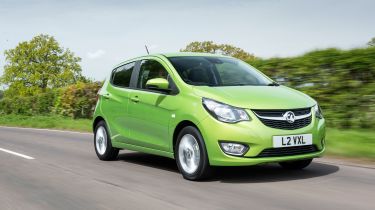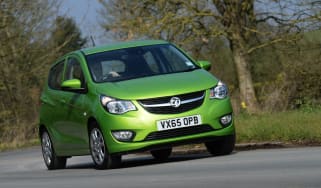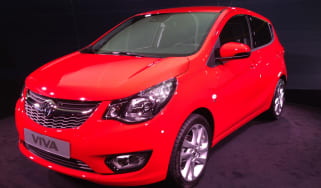Vauxhall Viva (2015-2019) review
The Vauxhall a well-equipped city car that represents good value, but there are better alternatives around

Smart looks, a generous kit list and low running costs count in the Vauxhall Viva’s favour, plus the optional IntelliLink touchscreen infotainment system is well ahead of rival set-ups. Yet while the Viva is easy to drive and park, it lacks the dynamic polish of some rivals and feels out of its depth away from the city.
Inside, the cabin is dark and drab in places, while space is reasonable, but not class leading – a Citigo or i10 offers more room for passengers and luggage. But the Viva is still far more accommodating than city cars of old.
On the road, the Vauxhall is exactly what most buyers would want from a city car: safe, predictable and easy to manoeuvre. It rides and handles reasonably well, too. But the steering is vague, there’s quite a lot of road noise and the sole petrol engine option feels sluggish out of town. The Viva is efficient and cheap to run, but there are more rounded city cars on sale.
The Vauxhall Viva and SUV-inspired Viva Rocks are the smallest cars for sale in the Vauxhall line-up, but not for much longer. 2019 sees the city car (which is known as the Opel Karl in Europe) dropped from the range, as Vauxhall seeks to rationalise its model line-up.
Used - available now

2022 Vauxhall
Corsa
22,369 milesManualPetrol1.2L
Cash £12,515
2020 Mercedes
C-Class Coupe
30,519 milesAutomaticDiesel2.0L
Cash £11,380
2024 Volkswagen
ID. Buzz
10,198 milesAutomaticElectric
Cash £21,600
2022 Volvo
XC40
20,072 milesAutomaticPetrol2.0L
Cash £8,190It's not much of a surprise, because the Viva hasn't sold in big numbers, especially when compared with its 1960s and 1970s namesakes. And with a number of strong rivals in the class, the Viva was always fighting an uphill battle. Those rivals include class leaders such as the Skoda Citigo and SEAT Mii, plus the pricier VW up!, the Citroen C1, Peugeot 108 and Toyota Aygo trio, and cars such as the Hyundai i10, Kia Picanto and Suzuki Celerio.
The Viva was launched in 2015, and under the skin it uses running gear shared with then sister firm Chevrolet's Spark, a car that was discontinued in the UK in 2014. This tech was re-engineered for the Viva, although the traditional front-engine, front-wheel-drive layout in a five-door hatchback body remained. Engine choice is limited to a 71bhp 1.0 73PS three-cylinder petrol with a five-speed manual gearbox, while an auto was also offered for a while.
The initial model line-up comprised standard, SE and SL variants, while the Viva Rocks was added at a later date. This was the de facto flagship, so featured lots of kit as well as an 18mm taller ride height and chunky black plastic cladding to create a fake SUV, similar in concept to the Kia Picanto X-Line.
Electric mirrors, cruise control, a trip computer and central locking feature on all cars, although air conditioning was an option. The SE Nav adds Vauxhall's Intellilink 4.0 infotainment system with sat nav, it was a pricey addition new, but well worth seeking out on a used model, as it's one of the most hi-tech nav systems you'll find in this part of the market. SL models add climate control, a USB socket and Bluetooth phone connection, 15-inch alloy wheels and a leather-covered steering wheel.
Engines, performance and drive
A decade ago most city cars were unrefined, uncomfortable and slow. But in the last few years a number of models have improved the breed considerably, so the Vauxhall Viva has a tough job on its hands.
The Viva’s platform is based on the Chevrolt Spark, so it's not the most advanced, but the whole car weighs in at just 950kg. That makes it nippy and agile around town, which is helped by the light steering, easy gearchange and decent all-round visibility. The ride is acceptable, but big bumps can unsettle it. As a first car or urban runabout, it fits the brief perfectly. The Viva comes with a City steering mode, which delivers more assistance to the steering for parking manoeuvres. But the wheel is already so light that you’ll probably never need it.
The Vauxhall Viva is not completely out of its depth on faster roads, either. Point the Viva’s stubby nose down a twisting back road, and it’s clear it doesn’t have the abilities of a Ford Ka+ or Skoda Citigo. But its handling is safe and predictable, although the firm suspension set-up is more easily unsettled by mid-corner bumps. There’s less grip on offer, plus the electrically assisted steering is overly light.
The Viva doesn’t ride as smoothly as its rivals, either. It patters and fidgets over broken urban tarmac, while large potholes send a shudder through the cabin. The Viva Rocks, with additional ride height and suspension travel, is marginally more comfortable.
On the plus side, the high-set driving position, light controls, decent visibility and compact dimensions make the Viva a doddle to drive on crowded city streets, while parking is easy even without the optional parking sensors.
Refinement isn’t perfect, either. The engine is fairly muted and wind noise isn’t too bad, but tyre roar and suspension noise is more noticeable than in rivals such as the Skoda Citigo and Hyundai i10. Still, the standard-fit cruise control means motorway journeys are manageable.
Engine
Unlike most rivals, the Vauxhall Viva is only available with a single engine in one state of tune: a 1.0-litre petrol. The three-cylinder unit is found in the Astra and Corsa, but there it has a turbocharger to shift the heavier kerbweight. While it originally had 74bhp, later versions are slightly less powerful at 72bhp. The figures below are for the older 74bhp model.
Only a few rivals offer turbocharging in this class, and while the Viva matches the more powerful Skoda Citigo for power and torque, it loses out to the Ford Ka+, which has a four-cylinder unit. The Vauxhall tips the scales at 939kg, which is 74kg more than the Citigo and only 70kg less than the Ka+, but the Viva was the slowest car from 0-60mph when we tested them back-to-back, with a time of 13.5 seconds. Yet despite producing peak torque of 95Nm at a heady 4,500rpm, the Vauxhall matched its rivals during our in-gear tests.
The 1.0-litre engine is noisier than the similar unit in the Citigo, but it revs eagerly and benefits from a characterful rasp when extended. The gearbox also benefits from a precise action. Overall the engine is nippy around town and has a decent turn of pace in the lower gears. The main problem, however, is that it lacks low-end torque and it requires revving to get the best out of it.
Overtaking will prove difficult on faster roads, and the long fifth gear means you’ll be changing down quite often on the motorway. That’ll hurt fuel economy, too.
Of course, this is a city car, but most competitors don’t feel quite as out of their depth at speed as the Viva does. At least the engine is smooth and quiet, so it doesn’t intrude when you have to rev it out.
MPG, CO2 and Running Costs
One of the most important reasons for buying a city car is that it’s inexpensive to buy and run. The Vauxhall Viva nails the former and it’s pretty good at the latter – but not the best in its class.
The 1.0-litre petrol engine has undertaken the most recent WLTP economy test, and it returns up to 46.3mpg. That's the same figure recorded for the Viva Rocks, and you should be able to easily match that in everyday driving.
If you want to find the most efficient Viva, then seek out SE cars with the ecoFLEX pack. Tweaked spoilers and low rolling-resistance tyres, plus the removal of the air-conditioning, means a return of 65.7mpg on the older NEDC cycle, up from 61.4mpg for the standard model.
It’s not as frugal as some eco-specials, however - the Dualjet version of the Suzuki Celerio manages an impressive 78.4mpg, for example. It’s a shame that Vauxhall didn’t choose to offer stop/start on the ecoFLEX, too, which would have made the savings more noticeable.
Insurance
The Viva starts at insurance group 3 – not as low as the Skoda Citigo but about average for the class. SL spec only raises that to group 4, too, so there will be little difference in cost.
Depreciation
Because city cars cost so little to buy, depreciation isn’t as big a concern as with more expensive models - there’s just a lot less cash to shed. It’s still something else to factor in when you look at running costs, though, and the Vauxhall Viva fares pretty well. It’s expected to retain between 39 and 42 per cent of its value after three years of ownership, which is on a par with the best in the class and better than the Toyota Aygo. That means even the cheapest version will be worth just over £3,500 after all that time.
To get an accurate valuation on a specific model check out our free car valuation tool...
Interior, design and technology
The Vauxhall Viva looks nothing like the old HA, HB and HC Vivas it shares its name with – Vauxhall has shunned the retro theme that MINI and Fiat are caught up in right now. Instead, the Viva looks like a conventional city car.
The overall profile is very similar to a Hyundai i10, but the small Vauxhall has a smart and unpretentious look that should appeal to most buyers in this price range. Sloping shoulder lines, slashes along the doors and an attractive rear-end ensure the Viva doesn’t look like a bargain basement model.
It’s not got much in the way of style or character, though, and the list of personalisation options for the exterior is measly. If you want to stand out, a Renault Twingo or Toyota Aygo are a better bet. Alternatively, the jacked up looks and exclusive alloy wheels of the Viva Rocks could swing you.
The inside carries on with the smart and classy theme, with an attractive dashboard layout, instruments borrowed from more expensive Vauxhalls and gloss-black plastic on the centre console. The plastics are hard and scratchy to the touch, but you would expect that from a car of the price, although like the outside it’s disappointing there are no extra colour choices to enliven the expanse of dark materials.
The Viva is well equipped, however. Remote central locking, cruise control, electric windows and mirrors and a trip computer are all standard, but buyers will want to spend an extra £500 on air-conditioning – you’ll struggle to sell one on without it. SL spec, with its leather steering wheel, leather-effect seat trim, climate control and alloys packs in a decent amount of kit. We’d probably save that and opt for the IntelliLink system, though.
Sat-nav, stereo and infotainment
Vauxhall is ahead of rivals in this area, at least in terms of the optional system on offer. SE models get a fairly basic FM radio with pre-sets and a dot-matrix screen, plus audio controls on the steering wheel. There’s no Bluetooth or USB connectivity as standard.
Vauxhall’s neat IntelliLink system puts it ahead of city car competition. While the standard R300 BT Radio is a straightforward unit that offers Bluetooth and USB connectivity, around £450 added the brand’s intuitive touchscreen arrangement.
Featuring a large seven-inch screen with crisp graphics, the R4.0 system is packed with useful features, including Apple CarPlay and Android Auto. These systems allow you to seamlessly link your smartphone and access all its features while on the move. The upgrade also includes a DAB radio tuner. The unit is simple to use, thanks to its clear layout.
Practicality, comfort and boot space
No city car is designed to carry big loads for long periods of time, but its nice to know the Viva can handle passengers and a small amount of luggage for short trips within its five-door body. There’s reasonable space for two adults in the back, although there are similarly-priced rivals with bigger boots.
Visibility is good at the front, although the rising shoulder lines make the rear windows a bit narrow. At least they wind down rather than pop out like they do in rivals. The blunt rear end shape and small size means the Viva is a doddle to park. Parking sensors are on the options list for those who still think they’ll struggle.
Dimensions and size
The Viva is 3.68m long, 1.49m tall, 1.6m wide and has a 2.39m wheelbase. That makes it very similar in size to the Hyundai i10, and slightly bigger than the VW up!. It’s the perfect size for town driving, while the short bonnet and flat rear-end makes it a cinch to park.
Head room, leg room and passenger space
The Viva is a good city car for carrying adults in the back on short journeys, although its by no means the best. Headroom is good thanks to the tall shape, and there’s just enough legroom for a six-foot adult to squeeze behind a similarly-sized driver.
All cars come with three proper seatbelts in the back. You wouldn’t want to sit three abreast for too long, but at least you have the option, unlike some strict four-seaters in the class.
Boot space
Opening the Viva’s tailgate reveals a 206 litre boot space – for comparison, the VW-Group trio of city cars (the up!, Citigo and Mii) measure in at 251 litres, while the Suzuki Celerio leads the pack with 254 litres.
There’s no underfloor storage, and a spare wheel is optional, but at least you can spec one. You also get 60/40 split-folding rear seats as standard, which is a bonus. It’s a shame they don’t fold completely flat and there’s a big loading lip, but the 1,013 litre total capacity isn’t to be sniffed at. The seat-bases in the back flip up to give a flatter floor when the bench is lowered, but the backs can’t be folded without removing the headrests first.
Reliability and Safety
The Viva uses tech from elsewhere in the range, but although these components have proven reliable, the brand doesn’t have the strongest reputation. Vauxhall regularly finishes in the lower half of the Driver Power survey, while its dealer network does equally poorly.
The Viva is a relatively simple car, so there’s little complex electrical equipment to go wrong. Be aware if you’re buying used that these types of cars are often bought by driving schools, so engines, brakes and clutches can have a hard life.
When it comes to safety, the Viva is a pretty good performer. Stability control, six airbags, tyre-pressure monitoring and lane-departure warning are all fitted as standard on even the basic SE variant.
However, a lack of any autonomous braking features to reduce the likelihood of town-speed shunts mean the Vauxhall could only manage a four-star Euro NCAP crash test rating in 2015, while a re-test under the stricter test regime in 2017 saw that rating revised down to three stars, with lower scores in all four categories.
Warranty
Vauxhall dropped its class-leading lifetime warranty in 2014, so the Viva makes do with a fairly standard three-year, 60,000-mile guarantee. While that’s on a par with the likes of VW’s up! and the Suzuki Celerio, it trails the Hyundai i10’s five-year warranty and the Kia Picanto’s seven-year agreement. That being said, there’s very little in the Viva to actually go wrong, and the powertrain and equipment on offer is well-proven.
Servicing
Despite the average warranty period, the good news is that Vauxhall’s dealer network is extensive and parts are both reasonably priced and abundant. The Viva needs attention every 12 months or 12,500 miles, which isn’t the longest service interval around, but it shouldn’t be expensive for dealers to carry out a service given how simple the city car is.
Vauxhall offers a number of fixed priced servicing deals, warranty extensions and service package offers with its new cars, so you’ll probably find it’s extremely cheap for the first few years.










